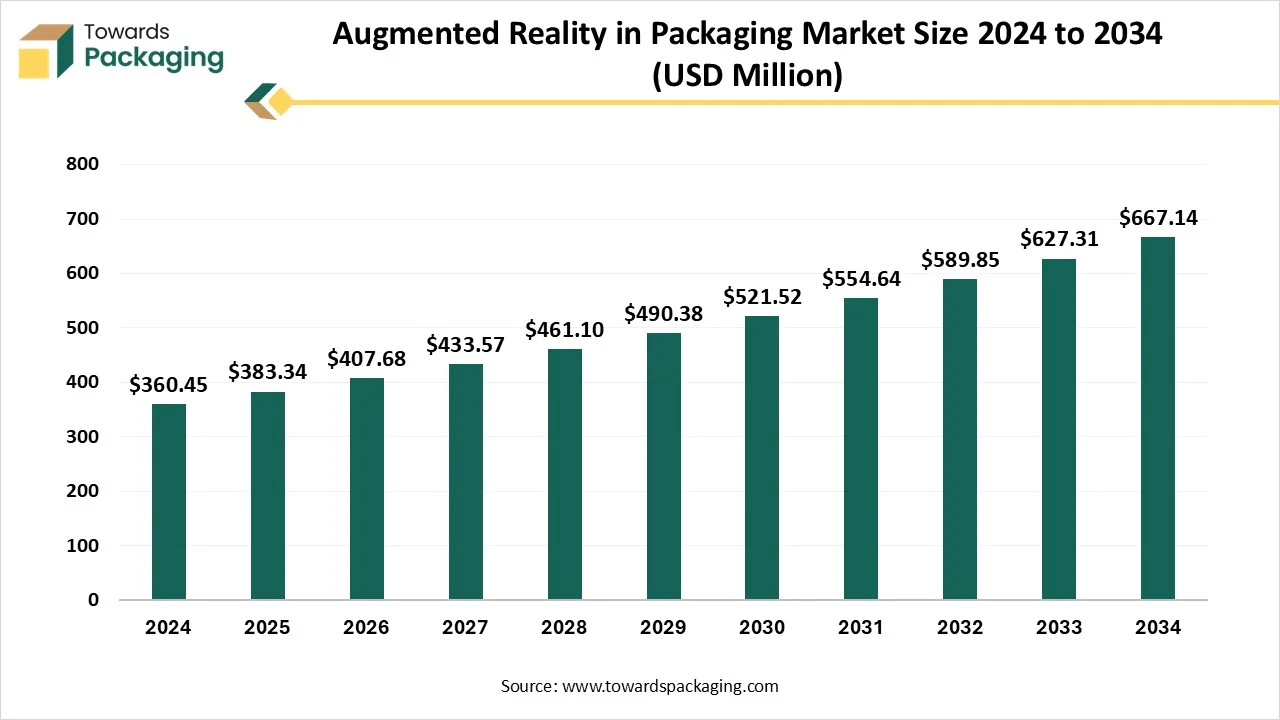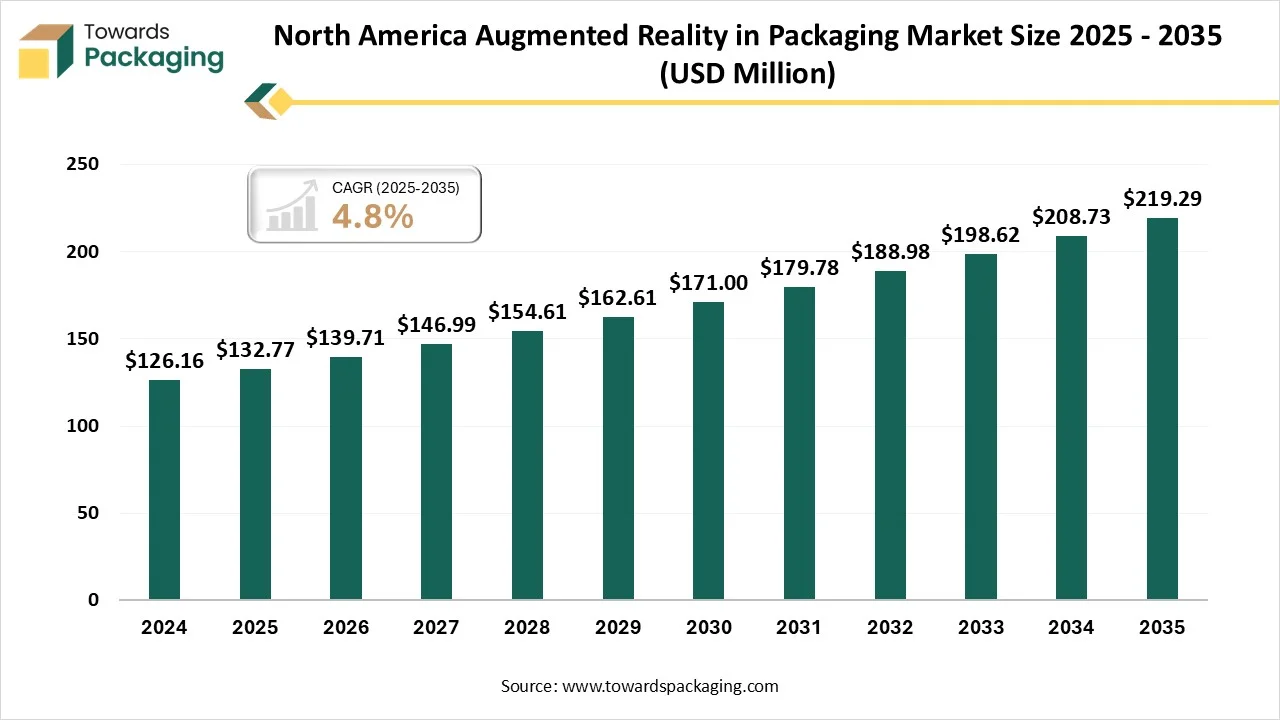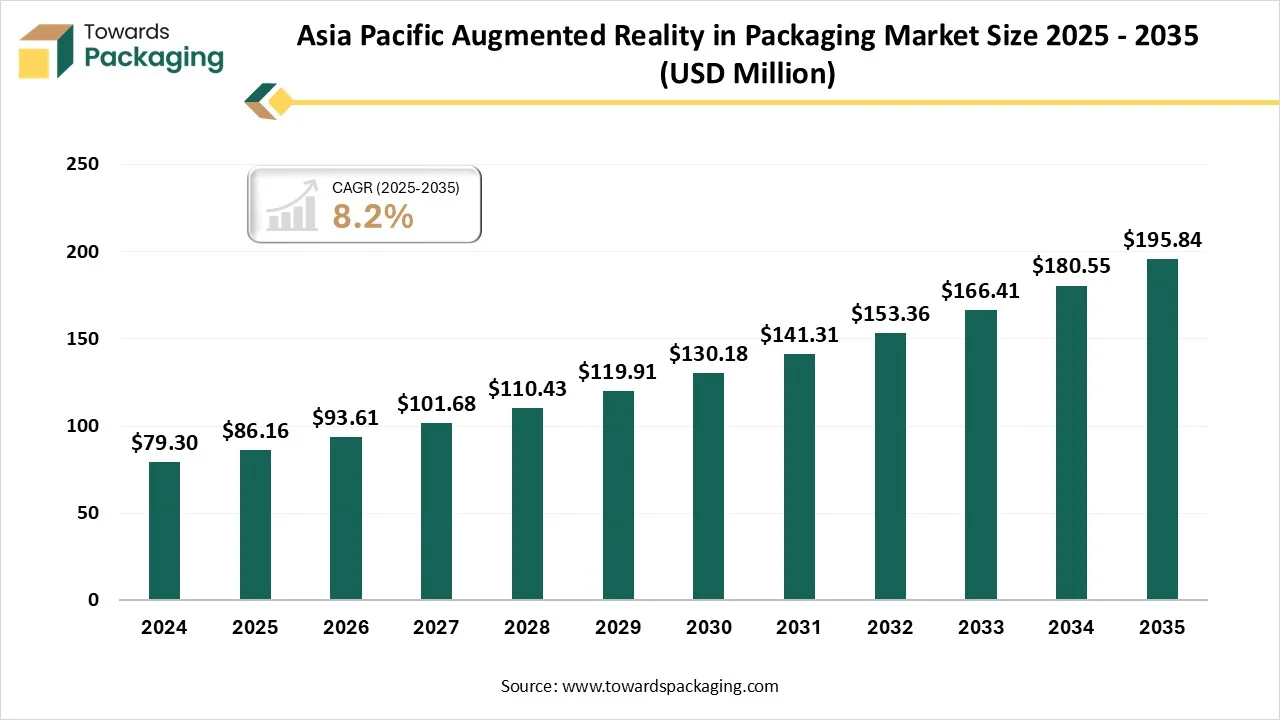December 2025
The augmented reality in packaging market is projected to grow from USD 407.68 million in 2026 to USD 709.50 million by 2035, with a CAGR of 6.35% during the forecast period. The North American region currently holds the largest market share, around 35%, driven by the rapid incorporation of AR in smart retail packaging. Asia Pacific is expected to see significant growth due to increasing smartphone penetration and digitalization. The market is segmented by AR technology type (e.g., marker-based AR, NFC/RFID-triggered AR), packaging type (e.g., AR-enabled labels & stickers), application use cases (e.g., marketing & brand engagement), and end-user industries (e.g., food & beverage). Key players include HP Inc., Zappar Ltd., Amcor PLC, and PepsiCo, Inc., among others. The market is also driven by advancements in NFC technology, AI integration, and interactive consumer experiences, with a notable growth in the luxury & fashion sectors and e-commerce platforms.

The Augmented Reality (AR) in packaging involves the integration of AR technologies into product packaging to enhance consumer engagement, improve brand storytelling, and provide interactive experiences via smartphones, AR-enabled apps, and wearable devices. This market covers AR-enabled labels, smart packaging, QR-code/marker-based AR, NFC/RFID-triggered experiences, and holographic packaging solutions used in industries such as food & beverages, cosmetics, consumer goods, electronics, and pharmaceuticals. Growth is driven by rising consumer demand for immersive shopping experiences, increasing smartphone penetration, brand differentiation strategies, e-commerce packaging innovations, and the use of AR for product information, marketing, and sustainability communication.
The Augmented Reality in packaging market is experiencing major technological shift which make it cost-effective and more scalable. There is a huge demand for enhancing virtual experience of the consumers. It allows brands to include recipes and nutritional information through analytics. The major advancement comprises AI and cloud integration, web-based AR, data tracking, 3D models and animation, NFC tags, and customization. After scanning a QR code, NFC tag, or image marker provided on a product packaging by using a tablet or smartphone, consumers can see cooperating features like tutorials, games, 3D animations, or virtual characters overlapped on the packages through the screens of the device. This technology permits brands to generate immersive and expressively appealing experiences, improving brand recall, social media shareability, and consumer engagement.
| Metric | Details |
| Market Size in 2024 | USD 360.45 Million |
| Projected Market Size in 2034 | USD 667.14 Million |
| CAGR (2025 - 2034) | 6.35% |
| Leading Region | North America |
| Market Segmentation | By AR Technology Type, By Packaging Type, By Application / Use Case, By End User Industry, By Distribution / Implementation Model and By Region |
| Top Key Players | Blippar Ltd., Seiko Epson Corporation, Xerox Corporation, Novalia Ltd., Mondelez International, Nestlé S.A., L’Oréal S.A., PepsiCo, Inc., The Coca-Cola Company, Kimberly-Clark Corporation, Procter & Gamble Co., Amazon, Alibaba. |
The major raw materials utilized in this market are cardboard and paperboard, glass and metal, trigger markers.
The component manufacturing in this market comprises the production of software and hardware.
This segment comprises enhancing accuracy, communication, and efficiency across the entire supply chain.
The marker-based AR (QR codes, barcodes, printed markers) segment dominated the market with highest share in 2024 due to high reliability and cost-efficiency. Marker-based AR utilizes logos, QR codes, or image markers on packing, contributing a simple and charge-operative way to participate digital content. Customers can simply access AR involvements by scanning the markers by using their smartphones, eradicating the requirement for focused hardware. This comfort of utilizing and convenience create marker-based AR an extremely operative tool for improving consumer interaction and experience. It is extensively utilized in marketing movements and helps a diversity of submissions, from advertising content and invention tutorials to verification landscapes.
The NFC / RFID-triggered AR experiences segment is expected to grow at the fastest CAGR during the forecast period. This segment is growing due to it enhanced functionality. It transforms static packing into a collaborative marketing device. Brands can provide selected games, videos, or advancements with a modest tap, nurturing deeper brand faithfulness. NFC tags along with exclusive digital signatures can confirm goods legitimacy, which is important for luxury products, pharmaceuticals, and enhanced-value for electronics. This supports combat fraud and shapes customer trust. Some of these tags can even inform if a packaging has been unlocked.
The labels & stickers (AR-enabled product labels) segment dominated the market with highest share in 2024 due to its scalability and cost-effectiveness. Augmented reality labels change static packing into a stand for energetic storytelling, allowing brands to spread their tale through 3D animations, immersive experiences, and videos. Customers can entree a prosperity of data not conceivable on an old label, like thorough component lists, utility instructions via video lessons, or facts regarding sustainability practices. This segment comprises submissions for virtual goods trials, permitting customers to envision goods in their own situation before buying.
The custom & promotional AR Packaging (limited editions, seasonal campaigns) segment is expected to grow at the fastest CAGR during the forecast period. This segment is growing due to brand differentiation and marketing campaigns. Augmented reality permits brands to shift elsewhere than the limited space to share premium, immersive brand stories. For periodic or limited-version goods, this allows brands to generate an extra emotional and in-depth connection with customers. Unique augmented reality experiences, such as animated characters display over a cereal box, boost employers to seizure and share their connections over social media platforms. This provides brands valued organic revelation and intensifies the grasp of their movements. The flexibility permits for besieged, appropriate messaging without varying the original physical set.
The marketing & brand engagement segment dominated the market with highest share in 2024 due to its immersive and interactive marketing tools. Augmented reality alters packing from a still superficial into an active stage for interface, moving beyond inactive drinking to active appointment. By manufacturing the interface more fun and useful, brands can suggestively upsurge customer appointment, which can result in higher fulfilment and constancy. AR involvements can make goods more notable and generate chances for viral advertising as customers share exclusive and exhilarating involvements with others. It can connection the opening between the digital and physical worlds, incorporating with additional digital networks such as mobile apps and social media for a more unified consumer journey.
The gamification & loyalty programs segment is expected to grow at the fastest CAGR during the forecast period. This segment is growing due to its potential for strengthening brand connections. Traditional point structures are completed more appealing by gamifying the procedure of earning rewards. Consumers can gather virtual symbols or facts by finalizing augmented reality trials, like scanning diverse goods in a supply.
The food & beverage segment dominated the market with highest share in 2024 due to enhanced customer engagement. Brands can effortlessly share comprehensive data such as allergen alerts, nutritional facts, and sourcing, straight on the packing, sustaining customer worries about health and food safety. This packaging offers a cost-operative method for brands to imprisonment consideration, build trustworthiness, and endorse goods in advanced customs. This segment is influenced by increasing customer demand for interactive and transparency packaging.
The luxury & fashion segment is expected to grow at the fastest CAGR during the forecast period. This segment is growing due to virtual try-on facilities and premium experience. It allows consumers to virtually try several products, like shoes, makeup or accessories, directly from the packing. This supports consumers better visualize goods and enhances self-assurance in online acquisitions, which can decrease product returns.
The direct-to-consumer brand packaging segment dominated the market with highest share in 2024 due to enhanced shopping experience. Customers can entree detailed data, such as component sourcing or useful instructions, straight through the packing, which can shape trust. Generating memorable and modified experiences via augmented reality create a brand more advanced and can upsurge consumer interest and trustworthiness. This packaging works as a straight line of statement between the company and the customers, permitting for real-time informs and an enhanced personal network.
The third-party AR technology vendors / SaaS solutions segment is expected to grow at the fastest CAGR during the forecast period. This segment is growing due to enhanced brand visibility. This technology changes a still material into a collaborative experience, growing consumer engagement and trustworthiness. It permits brands to offer additional content like classes, instructions, or sustainability proofs without filling the physical packing. Its information can be effortlessly rationalized for new movements or elevations without requiring to reshape and reissue the physical packing.

North America held the largest share in the augmented reality in packaging market in 2024, due to rising incorporation of augmented reality in the packaging sector. This technology in smart retail packing is an important influencer, as brands looking for creating immersive shop practices that connect the hole between digital and physical retail. With main e-commerce and retail chains giants capitalizing in omnichannel plans, AR-allowed packing is being utilized to provide virtual product test, real-time component transparency, and collaborative elevations.
Presence of Tech-driven Consumers Boost Augmented Reality in Packaging Market in the U.S.
U.S. is dominating in the augmented reality in packaging market in North America region due to the presence of tech-driven consumers. Majority of companies incorporate augmented reality into their branding and marketing creativities. With the huge development of direct-to-consumer (DTC) models and digital commerce, brands are utilizing this packaging technology to offer immersive storytelling, inventions, and collaborative marketing. The robust occurrence of tech giants and advanced setups in the U.S. is hastening the expansion of cutting-edge AR packaging resolutions driven by 5G connectivity, AI, and cloud computing. As tech-savvy customers assume more informative and interactive brand involvements, U.S. corporations are capitalizing profoundly in AR packing to improve brand diversity and buyer loyalty.

Asia Pacific expects the significant growth in the market during the forecast period. This market is growing due to rapid digitalization and huge utilization of smartphones has influenced the demand. As mobile business becomes a leading force in this region, several brands are adopting augmented reality packing to offer unified digital connections, from virtual creation demos to AI-influenced references. In businesses such as food & beverage, beauty, and personal care, augmented reality is being utilized to improve consumer experiences by providing tailored skincare formulation, virtual makeup tests, and collaborative product stories. With governments and trades heavily capitalizing in 5G organization, AR packing resolutions are becoming reachable and consistent, further fuelling their acceptance across several trades in Asia Pacific.
E-commerce Growth in China Promote the Augmented Reality in Packaging Market Growth
China has a huge augmented reality in packaging market due to rapid growth in the e-commerce sector. Enhanced number of smartphone presence in China has fuelled the growth of this market. Chinese customers are tremendously receptive to brands and digital technologies, are utilizing AR technology in packaging to offer appealing shopping involvements that decrease the opening between online and offline channels. In accumulation, the guidelines of the government of China supporting technological invention in the top-most companies to utilize this technology in packaging to influence consumer loyalty and engagement.
Europe is notably growing due to increasing demand for product authentication solution has influenced the growth of the market. With phony products producing significant economic losses and image damage, businesses are incorporating AR-based security facilities like blockchain-backed verification systems, digital watermarks, and holographic authentication. These choices permit customers and controllers to rapidly validate product genuineness by scanning AR-empowered packing, dropping the chances of fraud and confirming supply chain distribution.
Advanced Technology in Germany Promote the Augmented Reality in Packaging Market Growth
Germany has a huge market due to the presence of well-developed technological infrastructures. Increasing emphasis on innovation and quality to fulfil customer expectations. German customers are familiar for appreciating accuracy and detail which generates AR improved packaging an appropriate tool that can be utilized for the brands to carry the detailed data of the product through interactive videos and pictures. More, the emphasis on sustainable performs and open honesty regarding the product source and the procedures busy in its formation drives the corporations to utilize AR to interconnect these features efficiently to customers.
By AR Technology Type
By Packaging Type
By Application / Use Case
By End User Industry
By Distribution / Implementation Model
By Region
December 2025
December 2025
December 2025
December 2025